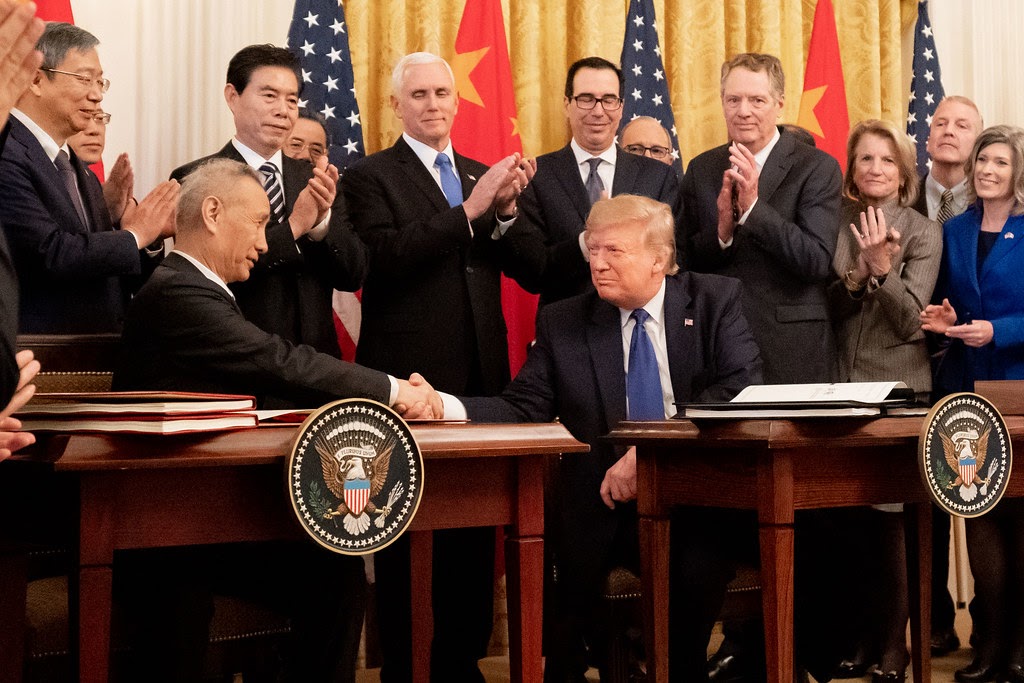
Trump and Chinese Vice Premier Liu He signed a new trade deal that is being called a major “first step” towards reaching a final, permanent agreement. Called simply the “Economic and Trade Agreement Between the Government of the United States and the Government of The People’s Republic of China,” this deal has been heralded as an enormous victory for the Trump Administration and the United States. But this view could not be further from reality.
While the agreement does take steps to repeal a few Chinese restrictions on agriculture products, China will maintain its 5% to 25% duties on $110 billion of U.S. imports. The deal does nothing to reduce tariffs on Chinese imports that have afflicted farmers in the Midwest.
Further, the deal contains a provision which requires China to purchase an additional $200 billion in U.S. products and services by 2021. This provision exposes fundamental problems with the Trump Administration’s understanding of the Chinese economic threat to world markets and American consumers.
The first problem with the Trump Administration’s policy is the trade deficit. President Trump enjoys touting the United States $419 billion trade deficit with China. The White House, however, lacks a basic understanding of what the trade deficit actually represents. The trade deficit is merely the value of goods and services purchased by the United States minus the goods we produce that have been purchased by other countries. It does not account for investment or all revenue items. Nor does the trade deficit offer any insight into what percentage the average American consumer spends of their income on foreign products.
The trade deficit actually grows during times of enormous prosperity. When the economy is good, consumers have more money to spend on goods and services and high foreign interest rates spur investment in the U.S. During the economic boom of the 1990s, the deficit tripled as middle-income and working class families enjoyed the largest period of uninterrupted growth in generations. Employing only the trade deficit to measure our economy’s well-being is as asinine as using a yardstick to calculate the distance to the Moon.
That is not to say that the Trump Administration has no reason to gripe about China. The Chinese government has been responsible for currency manipulation and intellectual property theft, as well as; violating international law and threatening U.S. national security. Our economy will be severely handicapped going forward if Chinese hackers continue to steal corporate information and product designs from foreign trade partners. Trump should be commended for emphasizing these issues.
But even where President Trump is right on our trade relations with China, he gravely miscalculates the correct solution. Rather than turn to global trade partners in the World Trade Organization or the North American Free Trade Agreement, the Trump Administration has repeatedly bashed and ridiculed both treaties as opposed to American interests. There is one massive and inconvenient hole in Trump’s argument, however: the World Trade Organization has largely sided with the United States when dealing with China. The United States has won a whopping 85% of its formal complaints against China at the WTO.
President Trump was made aware of the United States dominance at the WTO during a meeting two years ago, according to journalist Bob Woodward’s best-selling book, “Fear.” Contrary to what protectionists in the Trump administration have told him, China already faced close to universal opposition for their trade practices.
Taking on China’s economic malpractices never required an “America First” mentality or demanded we sour our relationships with strategic allies in Europe and Asia. Yet that has not stopped the Trump Administration from blocking the WTO from appointing new panelists on their board to review appeals and violating treaty rules concerning steel tariffs. As European Trade Commissioner Phil Hogan said, “The WTO is facing its deepest crisis since its creation.”
If President Trump truly wishes to successfully confront China on their economic abuses, he must set aside the political talking points on the trade deficit and refocus his efforts elsewhere. Trump can win this trade war, but it will take a dramatically different approach. He must abandon his “America First” trade policy and instead use the international trade bodies to force China into changing their patterns of intellectual property theft and currency manipulation. A single “phase one” trade agreement is merely winning a battle, not the entire war.
Matt Fisher is a senior studying politics.

